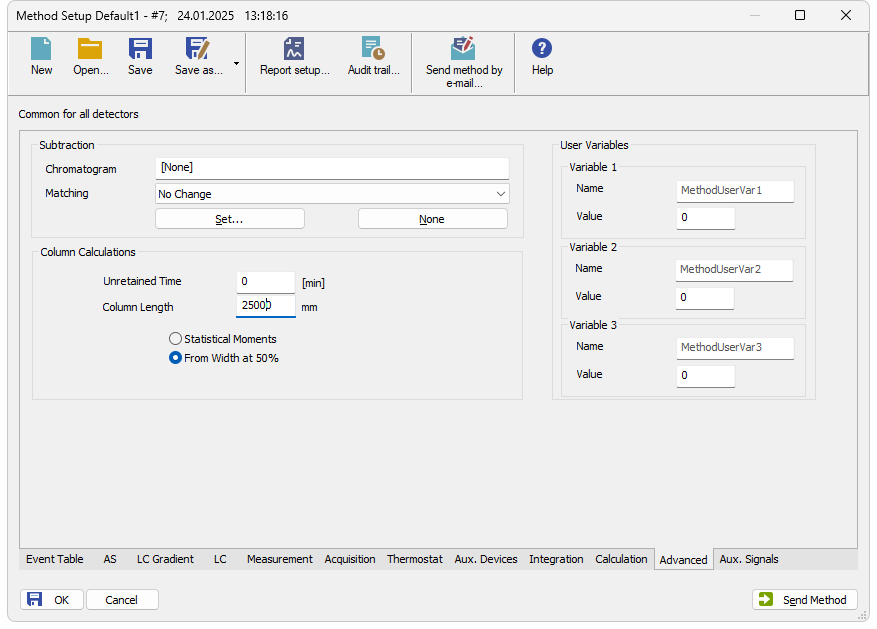Advanced
Sets other parameters of the method, most notably the Subtraction and Auxiliary Signals. When invoked by the menu command, the Method Setup - Advanced dialog will open. The tab is common to all signals while performing multidetector measurement.

Method Setup - Advanced
Sets an automatic subtraction of a previously measured chromatogram from the currently measured chromatogram. The subtraction will be indicated in the printout by the “mathematics” inscription. Use of subtraction is also shown in the Chromatogram Audit Trail.
The subtracted chromatogram has to be always present in the defined path. The change in the subtracted chromatogram influences the resulted subtraction in the current chromatogram.
If the chromatogram being subtracted has different number of signals than the method, only the signals present both in the method and in the subtracted chromatogram will be subtracted.
Note:
In the Data Acquisition window, the subtracted chromatogram may be displayed during a measurement in the background as a grey chromatogram. To display the chromatogram in the background without automatic subtraction (e.g., the solvent) use the File - Set Background Chromatogram… command.
A dialog for specifying the subtracted chromatogram.
Sets the method of the background chromatogram subtraction.
No change - The subtraction chromatogram will be subtracted from the measured chromatogram without any additional amendments.
Offset Subtraction Chromatogram - “Offsets” the measured chromatogram with the subtraction chromatogram by shifting it on the axis X (time axis) before the actual subtracting.
Scale Subtraction Chromatogram - “Scales” the measured chromatogram before subtracting by scaling the subtraction chromatogram on the time axis.
Note:
Alignment of chromatograms is achieved using the biggest peaks in the subtraction chromatogram, i.e. either to the highest peak or to the peak with the largest area.
Opens the Open Chromatogram dialog for selecting the file to be subtracted.
Cancels subtraction of the chromatogram.
Parameters affecting calculations on the Performance tab in the Chromatogram window.
Determines the unretained peak time of used column in minutes. This parameter is used to calculate the capacity ratio.
Determines the column length in millimeters. This parameter is used to calculate relative column efficiency.
Calculation runs based on statistical moments.
Calculation runs based on peak width at half the height and corresponding half-lengths.
Sets Method User Variables which can be used for User Columns calculations. Up to three independent variables can be set.
Sets the name of the variable. If the field is left empty, default name MethodUserVar1-MethodUserVar3 would remain filled in.
Sets the numerical value of the variable.